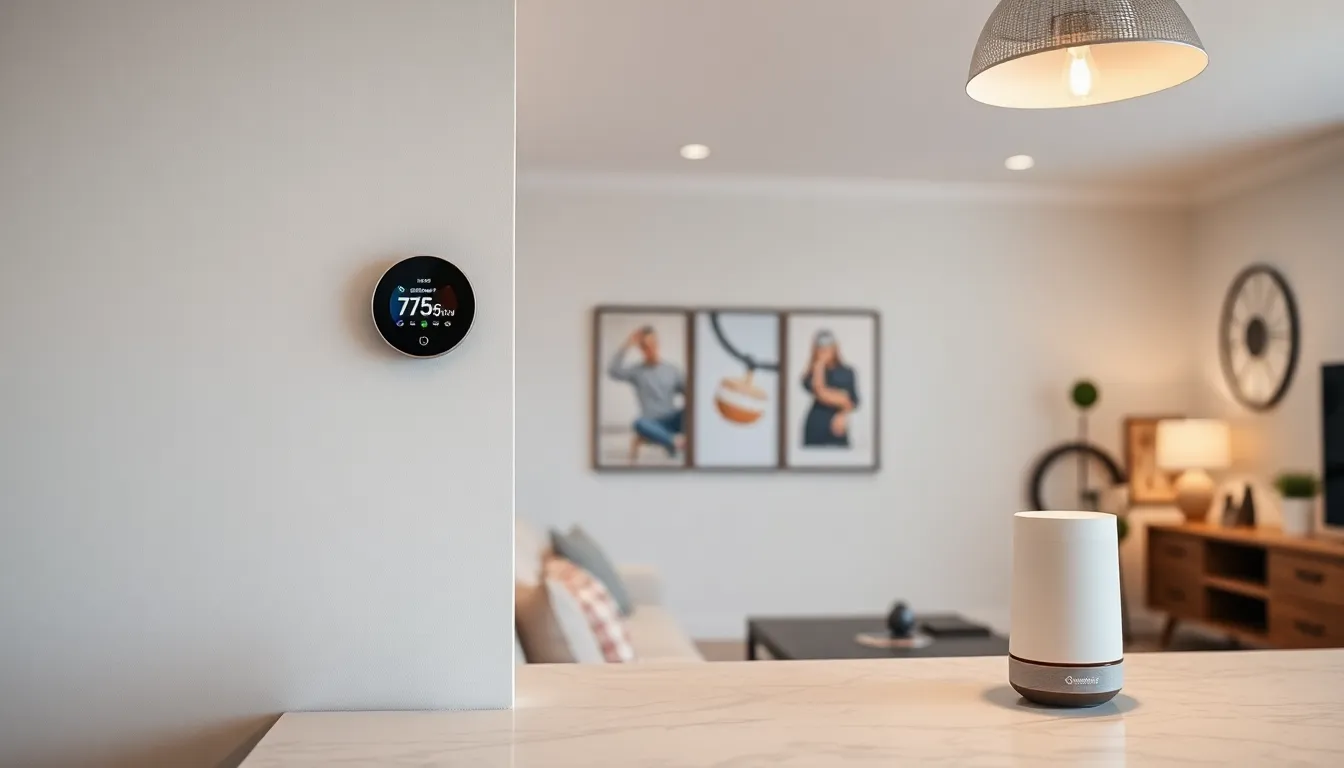Table of Contents
ToggleIn a world where even your toaster can send you a text, the Internet of Things (IoT) has transformed everyday objects into smart gadgets that can make life easier—or at least more entertaining. From homes that know when to start brewing coffee to smart fridges that remind you to buy milk, IoT projects are revolutionizing how we interact with technology.
Overview of IoT Projects
IoT projects focus on integrating devices with the internet to facilitate communication and data exchange. Many businesses leverage this technology to streamline operations. For example, smart agriculture systems use IoT sensors to monitor soil moisture levels, optimizing water usage and enhancing crop yield.
Additionally, smart cities utilize IoT for traffic management. Sensors embedded in streets gather real-time data, allowing city officials to adjust traffic signals and reduce congestion. Hospitals adopt IoT devices for patient monitoring, improving healthcare delivery and patient outcomes.
Manufacturers employ IoT for predictive maintenance. Sensors on machinery alert operators to potential failures before they occur, minimizing downtime and repair costs. Retailers implement IoT solutions to track inventory in real-time, thus improving supply chain efficiency.
Moreover, smart home projects offer convenience to consumers. Smart thermostats learn user preferences, adjusting temperatures automatically to save energy. Security systems equipped with IoT cameras provide real-time monitoring and alerts, enhancing home safety.
Each of these projects illustrates the versatility of IoT. Enhancements made through IoT applications lead to improved efficiency, cost savings, and better user experiences. The potential for innovation continues to grow as technology evolves.
Popular Types of IoT Projects

The landscape of IoT projects is diverse, reflecting innovations across numerous sectors. Below are key categories that showcase how IoT impacts daily operations.
Home Automation
Home automation enhances convenience by connecting devices that interact with users. Smart thermostats adjust heating and cooling based on learned preferences, which increases energy efficiency. Automated lighting systems respond to movement, making homes both secure and energy-saving. Voice-activated assistants control various devices, allowing seamless interaction. Security cameras provide real-time monitoring, ensuring safety while away from home. Devices such as smart locks offer enhanced entry security that can be managed remotely. These integrations make homes smarter and more responsive to individual needs.
Industrial Automation
In industrial settings, IoT projects enable streamlined operations and increased productivity. Sensors monitor equipment performance, which supports preventive maintenance and reduces downtime. Automated systems track inventory levels, ensuring timely restocking of supplies without human intervention. Data analytics from connected machines allow for enhanced decision-making regarding production efficiency. Companies can reduce operational costs by optimizing resource allocation based on sensor data. Enhanced workplace safety features monitor environmental conditions, ensuring compliance with safety standards. These applications transform industrial processes for greater overall efficiency.
Smart Agriculture
Smart agriculture employs IoT technology to optimize farming practices and enhance productivity. Soil sensors measure moisture levels, enabling efficient water usage tailored to crop needs. Drones monitor crop health from above, providing real-time data for immediate action. Automated irrigation systems respond dynamically to weather conditions, reducing waste while ensuring crops receive adequate hydration. Livestock monitoring devices track animal health and location, improving farm management. These IoT solutions contribute to sustainable farming by maximizing yields and minimizing resource consumption.
Key Components of IoT Projects
Key components play a vital role in the success of IoT projects. Understanding these elements helps in developing effective and efficient systems.
Sensors and Actuators
Sensors gather data from the environment, detecting changes in conditions like temperature, humidity, and light. Actuators react to the received data by executing physical actions, such as adjusting a thermostat or opening a valve. Each component works together to facilitate automating processes in various applications. For instance, smart agriculture relies on soil moisture sensors for precision irrigation. In smart homes, motion sensors trigger lighting systems, enhancing energy efficiency. Implementing reliable sensors and actuators ensures seamless interaction between devices.
Communication Protocols
Communication protocols enable devices to transfer data effectively across networks. Various protocols, such as MQTT, HTTP, and CoAP, cater to different requirements and bandwidth conditions. Each protocol serves unique use cases; for example, MQTT is lightweight and ideal for low-bandwidth scenarios, making it suitable for remote sensors. In contrast, HTTP fits better for applications requiring higher data throughput. Selecting the right protocol streamlines data exchanges and enhances overall system performance.
Cloud and Data Processing
Cloud services offer extensive storage and processing capabilities for IoT data. By leveraging the cloud, businesses can analyze vast amounts of information in real time. Big data technologies, such as Hadoop and Apache Spark, process incoming data efficiently, uncovering valuable insights. These insights drive decision-making in industries like healthcare, where patient monitoring data helps identify trends. Real-time processing capabilities in the cloud lead to timely responses, improving operational efficiency and customer experiences. Integrating cloud and data processing establishes a robust foundation for IoT projects.
Challenges in Implementing IoT Projects
Implementing IoT projects comes with several challenges that organizations must navigate. Security concerns dominate the landscape since connecting devices to the internet increases vulnerabilities. Hackers often target IoT systems, making robust security protocols essential.
Data management constitutes another significant challenge. Organizations frequently deal with large volumes of data generated by IoT devices that require effective storage, processing, and analysis. Without a properly designed infrastructure, insights might remain untapped.
Interoperability issues arise when integrating diverse devices and platforms. Different manufacturers produce IoT devices with varying communication protocols, making seamless integration difficult. Standardization in communication protocols could help alleviate this barrier.
Scalability represents another noteworthy challenge. As organizations expand their IoT implementations, maintaining performance and reliability becomes critical. Proper planning ensures that infrastructure can accommodate growth.
Costs can also become a concern in developing and deploying IoT solutions. Initial investments in hardware, software, and installation accumulate, while ongoing maintenance costs add to the financial burden. Organizations must budget meticulously to ensure sustainable operations.
Lastly, regulatory compliance often complicates project timelines. Different regions impose various regulations governing data privacy and device security. Staying informed about evolving legislation is crucial for organizations to avoid legal challenges.
Navigating these challenges requires comprehensive strategies and continuous efforts. Stakeholders must consider security, data management, interoperability, scalability, costs, and regulatory compliance to ensure successful IoT project implementation.
Future Trends in IoT Projects
Emerging trends in IoT projects highlight technological advancements shaping the future landscape. AI integration stands out, as artificial intelligence enhances data analysis and decision-making capabilities in IoT systems. These systems increasingly utilize machine learning algorithms to predict equipment failures, improving efficiency.
Another trend involves edge computing. This approach processes data closer to the source, reducing latency and bandwidth usage, while enhancing real-time decision-making. Businesses benefit from faster response times, as they analyze data without relying heavily on cloud infrastructure.
Sustainability demands also drive IoT innovations. Energy-efficient devices are becoming standard in IoT solutions, focusing on monitoring and reducing resource consumption. For example, smart grids optimize energy use, while agriculture implements sensors to minimize water waste.
5G technology significantly impacts IoT projects, as faster network speeds enable seamless communication between devices. With increased bandwidth, projects involving smart cities and autonomous vehicles flourish, improving connectivity and real-time data exchange.
Standardization efforts facilitate interoperability among devices, encouraging collaboration between manufacturers. As organizations push for compatibility, seamless device integration fosters more robust IoT ecosystems.
Data privacy and security concerns also influence future developments. Enhanced encryption methods and secure communication protocols will protect sensitive information generated by IoT devices. With trust as a priority, organizations will build secure environments for users.
Overall, these trends reflect a dynamic evolution within the IoT landscape. Innovation continues to drive advancements, enabling projects that enhance efficiency, sustainability, and user trust.
The landscape of IoT projects continues to evolve rapidly, showcasing the immense potential for innovation across various sectors. As organizations embrace smart technologies, they unlock new levels of efficiency and convenience that transform everyday experiences.
Addressing challenges like security and interoperability will be crucial for successful implementations. With advancements in AI, edge computing, and 5G technology, the future of IoT promises even greater capabilities.
The ongoing drive for sustainability and user trust will further shape the development of smart devices, ensuring that they not only enhance functionality but also align with modern demands. The journey of IoT is just beginning, and its impact on society will only grow stronger in the years to come.







